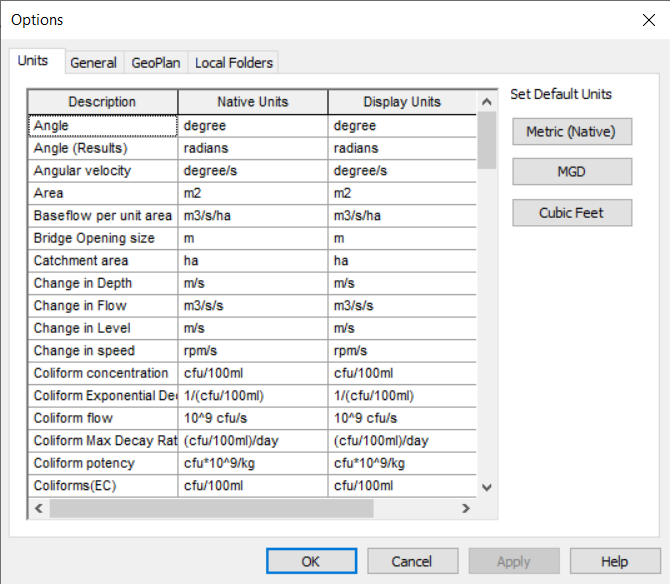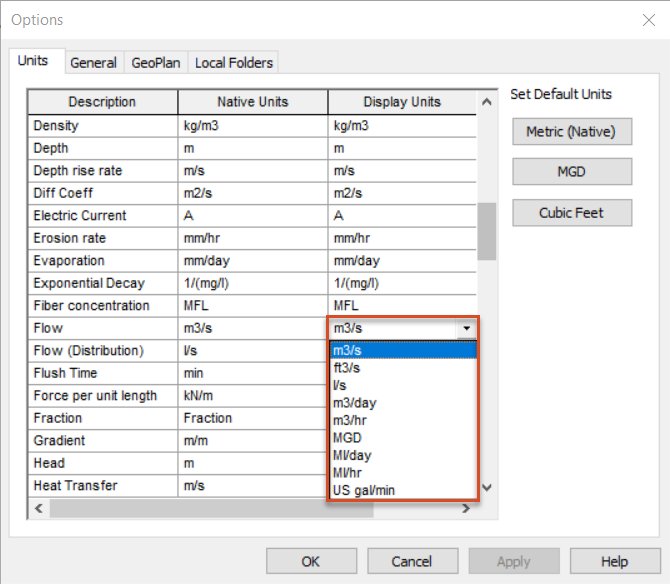& Construction

Integrated BIM tools, including Revit, AutoCAD, and Civil 3D
& Manufacturing

Professional CAD/CAM tools built on Inventor and AutoCAD
Transcript
00:02
You can change the measurement units used on ICM displays, including the Grid windows and property sheets.
00:11
From the Tools menu, select Options.
00:14
The Units tab lists the items for which data is held in the database.
00:19
For each item, the native units and display units are shown.
00:24
The Native Units are the units used for storing the data.
00:29
You cannot change these units.
00:31
The Display Units are the units used for all display and data-entry purposes.
00:37
Under Set Default Units, you can select a set of default display units.
00:44
Metric (Native): Sets the display to all native units.
00:49
MGD: Sets the display to imperial units with flows, change in flow, and volume units based on Mega Gallons per Day.
01:00
This option is mainly used in the US for sanitary and combined sewer modelling.
01:06
Cubic Feet: Sets the display to imperial units with flows, change in flow, and volume units based on cubic feet.
01:16
This option is mainly used in the US for storm water and water modelling.
01:23
Click OK to start using the new units.
01:27
You can also change the display units by selecting an option from the drop-down list for each field.
01:34
This can be useful for different model types.
01:37
For example, sewer modelling may use litres per second, while river modelling may use cubic metres per second.
01:45
If you make any changes, click OK to save the changes.
01:50
Any values entered in the grids or property sheets are displayed in the Display Units
01:56
but are converted to the corresponding Native Units for storage in the database.
00:02
You can change the measurement units used on ICM displays, including the Grid windows and property sheets.
00:11
From the Tools menu, select Options.
00:14
The Units tab lists the items for which data is held in the database.
00:19
For each item, the native units and display units are shown.
00:24
The Native Units are the units used for storing the data.
00:29
You cannot change these units.
00:31
The Display Units are the units used for all display and data-entry purposes.
00:37
Under Set Default Units, you can select a set of default display units.
00:44
Metric (Native): Sets the display to all native units.
00:49
MGD: Sets the display to imperial units with flows, change in flow, and volume units based on Mega Gallons per Day.
01:00
This option is mainly used in the US for sanitary and combined sewer modelling.
01:06
Cubic Feet: Sets the display to imperial units with flows, change in flow, and volume units based on cubic feet.
01:16
This option is mainly used in the US for storm water and water modelling.
01:23
Click OK to start using the new units.
01:27
You can also change the display units by selecting an option from the drop-down list for each field.
01:34
This can be useful for different model types.
01:37
For example, sewer modelling may use litres per second, while river modelling may use cubic metres per second.
01:45
If you make any changes, click OK to save the changes.
01:50
Any values entered in the grids or property sheets are displayed in the Display Units
01:56
but are converted to the corresponding Native Units for storage in the database.
Required for course completion
Measurement units used on ICM displays can be changed, including those on Grid windows and property sheets.
To view and change measurement units:
In the Options dialog box, the Units tab lists the items for which data is held in the database. For each item, the native units and display units are shown.

To change the display units:

This can be useful for different model types. For example, sewer modelling may use litres per second, while river modelling may use cubic metres per second.
IMPORTANT: Any values entered in the grids or property sheets are displayed in the Display Units but are converted to the corresponding Native Units for storage in the database.